#Show don't tell
Explore tagged Tumblr posts
Text
When Should You Describe a Character’s Appearance? (And When You Really, Really Shouldn’t)
It’s one of the first instincts writers have: describe your character. What they look like, what they wear, how they move. But the truth is — readers don’t need to know everything. And more importantly, they don’t want to know everything. At least, not all at once. Not without reason.
Let’s talk about when to describe a character’s appearance, how to do it meaningfully, and why less often says more.
1. Ask: Who Is Seeing Them? And Why Now?
The best descriptions are filtered through a perspective. Who’s noticing this character, and what do they see first? What do they expect to see, and what surprises them?
She looked like someone who owned every book you were supposed to have read in school. Glasses slipping down her nose. Sharp navy coat, sensible shoes, and an air of knowing too much too soon.
Now we’re not just learning what she looks like — we’re learning how she comes across. That tells us more than eye color ever could.
2. Use Appearance to Suggest Character, Not List Facts
Avoid long physical checklists. Instead, choose a few details that do double work — they imply personality, history, class, mood, or context.
Ineffective: She had long, wavy brown hair, green eyes, a small nose, and full lips. She wore jeans and a white shirt.
Better: Her hair was tied back like she hadn’t had time to think about it. Jeans cuffed, a shirt buttoned wrong. Tired, maybe. Or just disinterested.
You don’t need to know her exact features — you feel who she is in that moment.
3. Know When It’s Not the Moment
Introducing a character in the middle of action? Emotion? Conflict? Don’t stop the story for a physical description. It kills momentum.
Instead, thread it through where it matters.
He was pacing. Long-legged, sharp-shouldered — he didn’t seem built for waiting. His jaw kept twitching like he was chewing on the words he wasn’t allowed to say.
We learn about his build and his mood and his internal tension — all in motion.
4. Use Clothing and Gesture as Extension of Self
What someone chooses to wear, or how they move in it, says more than just what’s on their body.
Her sleeves were too long, and she kept tucking her hands inside them. When she spoke, she looked at the floor. Not shy, exactly — more like someone used to being half-disbelieved.
This is visual storytelling with emotional weight.
5. Finally: Describe When It Matters to the Story, Not Just the Reader
Are they hiding something? Trying to impress? Standing out in a crowd? Use appearance when it helps shape plot, stakes, or power dynamics.
He wore black to the funeral. Everyone else in grey. And somehow, he still looked like the loudest voice in the room.
That detail matters — it changes how we see him, and how others react to him.
TL;DR:
Don’t info-dump descriptions.
Filter visuals through a point of view.
Prioritize impression over inventory.
Describe only what tells us more than just what they look like — describe what shows who they are.
Because no one remembers a checklist.
But everyone remembers the girl who looked like she’d walked out of a forgotten poem.
#writeblr#writing community#writers of tumblr#writing tips#amwriting#character development#creative writing#writing advice#character design#show don't tell#narrative voice#fiction writing#creative writing tips#writing prompt
1K notes
·
View notes
Text
Some examples of "show, don't tell"
Telling: Leila was very angry.
Showing: Leila's face turned red, her fists clenched, and she slammed the door shut.
⸻
Telling: The room was messy.
Showing: Clothes were strewn across the floor, books were piled haphazardly on the desk, and dirty dishes filled the sink.
⸻
Telling: John was scared of heights.
Showing: John's palms grew sweaty, his heart raced, and he clung tightly to the railing as he looked down from the rooftop.
⸻
Telling: The food tasted delicious.
Showing: The flavors exploded on her tongue, a medley of sweet, tangy, and savory notes danced in her mouth, leaving her craving more.
⸻
Telling: Emma was sad about the breakup.
Showing: Emma's eyes welled up with tears, her shoulders slumped, and she spent hours curled up in bed, replaying their last conversation in her mind.
⸻
Telling: It was a beautiful sunset.
Showing: The sky transformed into a canvas of vibrant hues—pinks, oranges, and purples blending together in a breathtaking display, casting a warm glow across the horizon.
⸻
Telling: The car was old and unreliable.
Showing: The engine coughed and sputtered, emitting puffs of smoke. Rust covered the body, and the faded paint revealed years of wear and tear.
⸻
Telling: The meeting was tense.
Showing: The participants leaned forward in their seats, their brows furrowed, and their voices became sharp and clipped as they argued back and forth.
⸻
Telling: He was a kind person.
Showing: He often went out of his way to help others, offering a comforting smile and lending a listening ear whenever someone needed support.
⸻
Telling: The forest was eerie at night.
Showing: Shadows danced among the trees, the wind whispered through the branches, and the distant hooting of an owl sent shivers down her spine.
Here’s the Show, Don’t Tell freebie book and my newsletter.
#show don't tell#writing#writerscommunity#writer on tumblr#writing tips#writing advice#writer tumblr#writing help#writblr#fiction writing#writer community#writer stuff#creative writing
439 notes
·
View notes
Text
My small addition to the "show don't tell" advice of storytelling is that in my opinion it's okay to use writing pitfalls like "Telling" the audience something if you intend to Also demonstrate ("show") it in the story.
For example "This is a story about a very grumpy guy." (que your main character road raging) (inciting incident happens and your protagonist reacts grumpily to it). Like it's not an inherent flaw depending on how you execute it AND even more importantly, the tone of your story. If your story is quippy, self aware, self narrating or various flavors of humor or self observant, it's okay to Just Tell the audience things. Not all things, but it can work for comedic effect or for exploring character observation and psychology, or doing a commentary on something. Works especially well if your narrator is actually a character within the story (ie. Person recalling events to someone)
ALSO importantly, you can use "Telling" for subverting expectations which can work towards either humor Or discomfort brilliantly.
"This is a story about a very grumpy guy" (que main character reacting completely normally to an event) (main character's reactions are treated as somehow overtly absurd and exaggerated by other characters despite them being very tame and reasonable). See what I mean?
It's okay to tell some things:
- if it serves the tone of your story
- if you ALSO show
- if it's funny
- if it's existentially horrifying
- if it serves towards an unreliable narrator
- if it makes the story interesting
- if it's not the point of the story to "show" some particular thing at all
I know people are gonna interpret the "Show don't tell" advice many different ways, so I wanted to add my two cents to it. I have way more to say, but here's my take in defence of "Telling". I believe in art and writing there's a time and place for any kind of narrative tools if you work with them well enough and know what you're doing.
#Mod talks#Writing advice#Meta#Storytelling#Show don't tell#Writing#Writblr#creative writing#Tropes#story tropes#Writing tropes
169 notes
·
View notes
Text
Another Post About Showing and Telling
I feel like it’s a rite of passage for a writing blog to talk about show, don’t tell, so I’ll take a crack at it.
First of all, to get it out of the way, show, don’t tell is good advice for specific situations, but it’s been taken to mean always show, never tell and that’s not helpful. If you really want to paint with broad brushstrokes, then the better advice would be: Show more than tell. Showing and telling should both be tools in your writer’s toolbox.
But why should we show more than tell? Because showing is the key to the reader's emotional experience with your story. There are many posts and books out there that go over how to turn your telling into showing (like using active verbs instead of passive, for example, or using concrete, specific details in your descriptions), but I think it’s important to fully digest why we’re making those changes and why the reasoning will push us to become better writers.
It all comes down to emotion. Writing For Emotional Impact by Karl Iglesias encourages writers to start thinking to themselves: “I’m in the emotion-delivery business, and my job is to evoke emotions in a reader.” Dialogue, theme, setting, pacing, character development, word choice, structure, POV, showing and telling. These are all tools a writer uses in varying proportions to best manipulate a reader’s emotions. The good news is that when a reader picks up a book, they’re willing to be manipulated. In fact, they hope to be. The tough news is that you have to deliver on a sentence by sentence, paragraph by paragraph, scene by scene, and chapter by chapter basis. But that’s okay, because you’re a writer, dammit, and this struggle is where the art of the craft is.
Showing is where the emotional complexities of our characters, theme, and plot can be revealed gradually without giving too much away too early and robbing engagement from the reader. Showing is what makes the resolution and the journey satisfying. So you can see how much weight it carries and why we want more of that than telling. We’re trying to evoke emotion from the reader, not talk at them like we’re recounting a dream we had last night (yawn). And it’s easier to evoke emotion if we keep them curious. Engaged.
Part of revealing the story gradually through showing is planting evidence for a conclusion that you leave the reader to make themselves, or a conclusion that you will reveal later. Donald Maas in The Emotional Craft of Fiction writes, “The ingredient behind effective showing can be summed up in this word: subtext. When there’s a feeling we’re not being told, but it is evident anyway, that underlying feeling is the subtext. It’s the unspoken emotional truth.” And then a fandom is born and continues to thrive for decades after the show ended! Really, though. Subtext is an ingredient in showing, which fosters engagement, which makes the reader feel something. Sometimes passionately. Every story I love and keep coming back to in one form or another has that special place in my heart because of how it made me feel.
I’ll try to give a simple example here to illustrate subtext and reader engagement at work. Using setting and a couple action beats as an opportunity for subtext, let’s say a character and her sister arrive at their grandmother’s house. Character A remains standing in the corner when invited in, hugging herself, frowning at the green knitted blanket hanging over the couch that looks like the color of nausea. Character B walks easily into the living room, running her hand over the green blanket that reminds her of nature and wellness. In Character B's perspective, she admires her grandmother's craftiness. But it's only in Character's A perspective that we notice the store tag on the blanket. Who do we think has the better relationship with their grandmother, given the evidence? Which one seems more naïve or eager to see her grandmother in a certain light? What assumptions can we make about the grandmother? Might she be putting on a performance of being grandmotherly? The mental work the reader does here would be completely thwarted if the scene had started with “Hannah didn’t like her grandmother because she valued material wealth and appearances over forming a genuine connection with her family.” We can show that instead over time by filtering the world through the perspectives of our characters, and even making it pack an emotional punch if we’re strategic about it.
But I had mentioned that contrary to what show, don’t tell asks us to do, telling isn’t something we should throw away. It can be a tool in its own right.
Telling is explaining, and explaining keeps people distant from what’s happening in the story. How many times has an “I love you” felt kinda meh in a story because that character hasn’t earned that confession by showing their love through their actions or making some sort of sacrifice? How many times have your eyes glazed over while reading the fourth paragraph of an info dump? How many times, when talking about a book you just read, have you said “well, the first 80 pages were slow…” because it was all backstory? Or maybe a story is entirely forgettable because the telling leaves nothing to the imagination. Donald Maas writes, “Put on a page what a character feels and there’s a pretty good chance that, paradoxically, what the reader feels is nothing.”
However, telling has one thing on showing: efficiency. If a book only showed, then it could go on forever and ever. So a writer has to learn how to weave both showing and telling into the story to control the pacing and delivery of information. If you want subtext or you want something to be vague on purpose, then you’ll probably want to show. If you want to deliver information quickly and with clarity, then you might want to try telling. Does it need to make logical sense to understand the upcoming scene? Maybe tell. Is this transition unimportant to the story and you don’t want to linger? Try telling and see how it works! Ask your beta readers how it worked for them. Of course, if you’re writing in the literary genre, you might be doing a whole lot of telling because what propels the reader to the next page and the next chapter is the form, the prose, and the sheer depth of the exploration of flawed characters.
It’s all about balance. And practice. Next time you read a book and you find yourself moved, try to figure out how the author just evoked that feeling from you. Was it stated plainly, or was it shown through action? Was it stated plainly after a whole book’s worth of setup through subtext? Was it unexpected? What was the balance of showing and telling that led to it? Or, if you find your focus trailing off, try to figure out why. Then, when you’re editing your own work, you’ll have the tools you need to identify the weak points and make revisions. And it’s okay (even expected) if the perfect balance of showing and telling doesn’t occur in the first draft. The Artful Edit by Susan Bell (highly recommended) talks a lot about the revisions that went into The Great Gatsby. You'll find that his writing struggles are comfortingly familiar. Luckily, he certainly had a wonderful editor :)
For further reading/watching:
[VIDEO] ShaelinWrites—Show, Don’t Tell | what it means and how to use it
[BOOK] Showing and Telling in Fiction by Marcy Kennedy [BOOK] A Writer’s Guide to Active Setting by Mary Buckham
#writing advice#writing tips#writing community#writers of tumblr#writing#creative writing#writeblr#fiction#show don't tell
206 notes
·
View notes
Text
Update: It turns out that this isn't quite true, so if you see this, please check out the correction over here, thanks!
So apparently, "show don't tell" was pushed as Really Good Writing Advice in the 1950's because it kept writers from discussing political ideas that challenged the status quo.
Which like... obviously, "show, don't tell" can be useful sometimes, like if you're describing a terrifying monster! But pushing it as The Only Way To Write would definitely have a chilling effect on stories centering concepts and experiences unfamiliar to readers.
I find it both fascinating and a little disturbing how effectively censorship can be accomplished through simply convincing people that certain forms of expression are gauche.
2K notes
·
View notes
Text
These two stills nicely show the passage of time during Sauron's goo phase. Stalactites and stalagmites do not grow exactly quickly.
It's only after the shot in the second still that Blobron devours the poor rat.
It means he was a black puddle for a very long time before he turned into a spaghetti monster, crawled out of the cave, had a sled adventure, was run over by a carriage and turned into Halbrand... possibly not of the Southlands. :-)
It's a lovely example of "show don't tell."


#the rings of power#rop season 2#rop spoilers#trop spoilers#rop stills#myropstills#blobron#rop visual storytelling#show don't tell
256 notes
·
View notes
Text
one of the positives of "show don't tell" is that it can be used to make readers ask and then answer their own questions. this is great because it is always great to get readers thinking and involving their imagination and their perspective.
I'm watching a show where in one brief, silent scene characters drag corpses to a room labeled "compost." no other information is needed because the viewer (reader) can now supplement the missing information with their own knowledge or conjecture, further immersing them in the story.
317 notes
·
View notes
Text
The gradual degradation of Brennan's costume in Never Stop Blowing Up is a common environmental story telling trope in 80s action movies where the main character get progressively more injured but doesn't let it slow him down as he keeps fighting.
In a horror movie, these injuries would be slowing the character down, putting them in more peril, showing weakness and anguish.
In Action, it (at least) borders on comical how little injuries can matter - as Brennan showed in the hospital scene. Action is defiance of and triumph over death, it's about feeling like you're insanely tough, a badass who can defeat and overcome anyone and anything (physically).
The art and make up team here are telling a story. This is a character who exists parallel to our main story who is going through his own action journey, patching himself up when he can as he goes but bleeding through those bandages later as he rips a wound open that probably needed stitches but he doesn't have TIME to get a much needed blood transfusion, goddamnit, he's gotta get to the thing with the thing before the bad thing happens.
There's so many little interesting details unraveling in the story the make up is telling, like having one side of the body clearly have gotten exposed to an explosion. Meanwhile the cut on his left arm goes from open, to cleanly bandaged, to bleeding through the bandage. The latest episode brings us to the point in the movie where he finally just throws off the torn and bloodied dress shirt.
Which is part of action stories too, where the main character moves further and further from someone who was trying to be a Business Adult in the Real World before shit hits the fan and the battle can't be fought by a civilized man in a suit and tie, it's gonna get fuckin messy.
(as always please be mindful and respectful anytime you think about commenting on a performer's appearance).
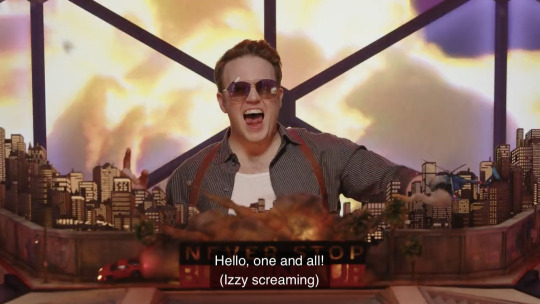
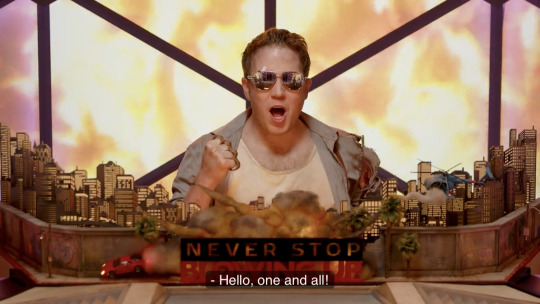
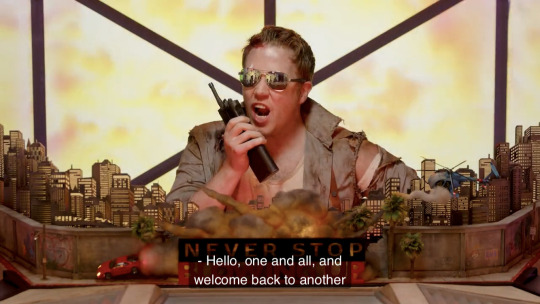
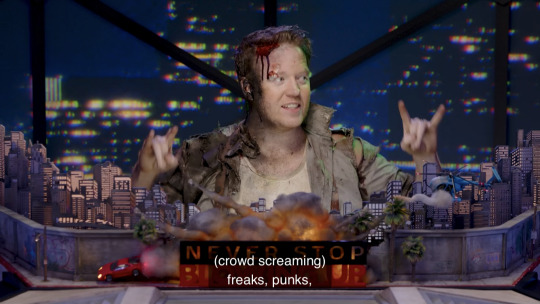
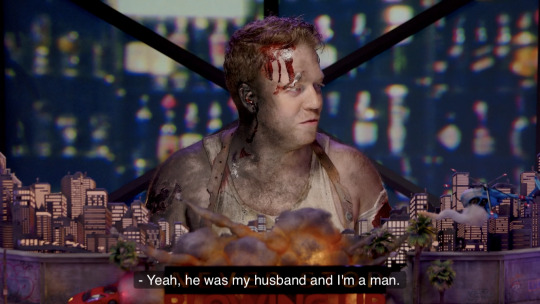
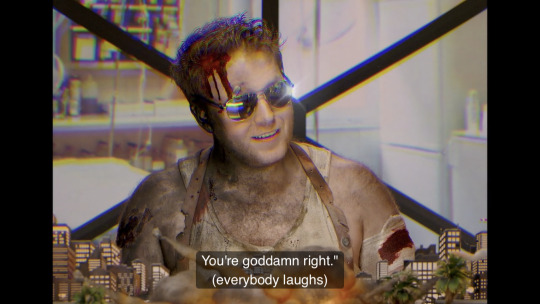
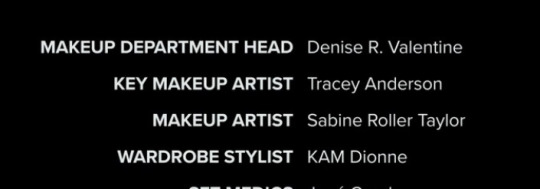
#dimension 20#dropout tv#Never Stop Blowing Up#80s#Action Movies#dropout#brennan lee mulligan#costume#cosplay#make up#Denise R Valentine#Tracey Anderson#Sabine Roller Taylor#KAM Dionne#environmental storytelling#show don't tell#media analysis#ttrpg#glow up#Kids On Bikes#Real Play#80s Action
257 notes
·
View notes
Text
Am I mad that we only got told by a twitter post, as an afterthought after all the upsurge of indignation for the treatment reserved to Sam Wilson as Captain America, that he indeed had already assembled the Avengers offscreen?
YES.
Do I consider it not just sloppy and weak writing, breaking the SHOW DON'T TELL rule even the worst fanfic writer knows?
YES.
Do I think that with little minimal creative thinking, they could've used either (or both) CABNW or TB* post credit scene to show exactly this process?
YES.
But boy. C'mon. CABNW has its weaknesses, but this is ALL on the TB* creative team. The movie could've answered this question and many other....yet today we're still fucking wondering (and waiting for the next A/N to appear in a tweet):
WHEN the fuck did Bucky got elected?
WHY did he choose to run for Congress?
WHO eventually decided to put him there?
WHICH is exactly his role in the Congress?
HOW did he get elected?
WHERE do his political opinions and goals stand?
Did we even get any fucking explanation about this WHOLE MESS of a career?!?
NO.
Jesus. I hate to admit it, but somehow such a pathetically bad writing makes me consider actually acceptable that Somehow, Palpatine returned....
#anti thunderbolts#bad writing#show don't tell#sam wilson#captain america#sam wilson is captain america#cabnw#bucky barnes#the Avengers™
64 notes
·
View notes
Text
Arcane season 2 is trully amazing. It achieved something I never thought was possible before.
It manage to botched character arcs for the sake of getting from plot point to plot point yet manage to abandon its own plot. Dropping plotlines, having the entire plot point happening just for character's interpersonal drama (like vi's parents killed by enforcer for caitvi drama).
And yet they failed to show piltover on interpersonal level (life as casual piltie), only giving us the audience the sight of piltover as a system (the rich who exploited the poor, the law makers, and the enforcers) and yet they treated the entire systemic issue that is happening as interpersonal problem.
Trying to be tragic but also hopeful so that the tragedy says something and yet because of that the situation just cycled back to square one.
How can they try to be everything and ended up as nothing? It's genuinely impressive at this point.
#arcane critical#this is what hapoened when you try to be#everywhere at the end of time#show don't tell#they gave us neither
136 notes
·
View notes
Text
A common misconception I hear people say about "show, don't tell" is that showing lengthens the description, but I find the opposite to be true. "Showing" involves the right word choice that portrays a lot in just a few words, whereas telling takes more words to describe things.
For example:
Telling: After Seth listened to the disturbing song, he said, "I am so traumatized. That song will give me nightmares. It has changed me forever."
Showing: After Seth listened to the disturbing song, he said, "I miss the person that I was three minutes ago."
#writing#writers#writeblr#writers on tumblr#creative writing#writing community#writing advice#writing tips#on writing#writing tips and tricks#authors of tumblr#author advice#show don't tell#creative process#tumblr writers#how to write#am writing
88 notes
·
View notes
Text
Zoom In, Don’t Glaze Over: How to Describe Appearance Without Losing the Plot
You’ve met her before. The girl with “flowing ebony hair,” “emerald eyes,” and “lips like rose petals.” Or him, with “chiseled jawlines,” “stormy gray eyes,” and “shoulders like a Greek statue.”
We don’t know them.
We’ve just met their tropes.
Describing physical appearance is one of the trickiest — and most overdone — parts of character writing. It’s tempting to reach for shorthand: hair color, eye color, maybe a quick body scan. But if we want a reader to see someone — to feel the charge in the air when they enter a room — we need to stop writing mannequins and start writing people.
So let’s get granular. Here’s how to write physical appearance in a way that’s textured, meaningful, and deeply character-driven.
1. Hair: It’s About Story, Texture, and Care
Hair says a lot — not just about genetics, but about choices. Does your character tame it? Let it run wild? Is it dyed, greying, braided, buzzed, or piled on top of her head in a hurry?
Good hair description considers:
Texture (fine, coiled, wiry, limp, soft)
Context (windblown, sweat-damp, scorched by bleach)
Emotion (does she twist it when nervous? Is he ashamed of losing it?)
Flat: “Her long brown hair framed her face.”
Better: “Her ponytail was too tight, the kind that whispered of control issues and caffeine-fueled 4 a.m. library shifts.”
You don’t need to romanticise it. You need to make it feel real.
2. Eyes: Less Color, More Connection
We get it: her eyes are violet. Cool. But that doesn’t tell us much.
Instead of focusing solely on eye color, think about:
What the eyes do (do they dart, linger, harden?)
What others feel under them (seen, judged, safe?)
The surrounding features (dark circles, crow’s feet, smudged mascara)
Flat: “His piercing blue eyes locked on hers.”
Better: “His gaze was the kind that looked through you — like it had already weighed your worth and moved on.”
You’re not describing a passport photo. You’re describing what it feels like to be seen by them.
3. Facial Features: Use Contrast and Texture
Faces are not symmetrical ovals with random features. They’re full of tension, softness, age, emotion, and life.
Things to look for:
Asymmetry and character (a crooked nose, a scar)
Expression patterns (smiling without the eyes, habitual frowns)
Evidence of lifestyle (laugh lines, sun spots, stress acne)
Flat: “She had a delicate face.”
Better: “There was something unfinished about her face — as if her cheekbones hadn’t quite agreed on where to settle, and her mouth always seemed on the verge of disagreement.”
Let the face be a map of experience.
4. Bodies: Movement > Measurement
Forget dress sizes and six packs. Think about how bodies occupy space. How do they move? What are they hiding or showing? How do they wear their clothes — or how do the clothes wear them?
Ask:
What do others notice first? (a presence, a posture, a sound?)
How does their body express emotion? (do they go rigid, fold inwards, puff up?)
Flat: “He was tall and muscular.”
Better: “He had the kind of height that made ceilings nervous — but he moved like he was trying not to take up too much space.”
Describing someone’s body isn’t about cataloguing. It’s about showing how they exist in the world.
5. Let Emotion Tint the Lens
Who’s doing the describing? A lover? An enemy? A tired narrator? The emotional lens will shape what’s noticed and how it’s described.
In love: The chipped tooth becomes charming.
In rivalry: The smirk becomes smug.
In mourning: The face becomes blurred with memory.
Same person. Different lens. Different description.
6. Specificity is Your Superpower
Generic description = generic character. One well-chosen detail creates intimacy. Let us feel the scratch of their scarf, the clink of her earrings, the smudge of ink on their fingertips.
Examples:
“He had a habit of adjusting his collar when he lied — always clockwise, always twice.”
“Her nail polish was always chipped, but never accidentally.”
Make the reader feel like they’re the only one close enough to notice.
Describing appearance isn’t just about what your character looks like. It’s about what their appearance says — about how they move through the world, how others see them, and how they see themselves.
Zoom in on the details that matter. Skip the clichés. Let each description carry weight, story, and emotion. Because you’re not building paper dolls. You’re building people.
#writeblr#writing community#writers of tumblr#writing tips#character development#creative writing#writing advice#character description#descriptive writing#show don't tell#world building#narrative voice#writing help#fiction writing#amwriting#writing characters
199 notes
·
View notes
Text
Instead of just saying, “She was sad,” let your readers feel it through the details. Is she staring out the window while it rains, her favorite song playing quietly in the background? Maybe she’s avoiding eye contact, or she can’t stop fidgeting with her phone. These little moments do more to show what’s going on inside than straight-up telling us she’s upset.
#writing#writerscommunity#writer on tumblr#writing tips#character development#writing advice#oc character#writing help#writer tumblr#writblr#creative writing#show don't tell
243 notes
·
View notes
Text
why i hate "show don't tell"
this is inspired by a convo with a friend. feel free to discard if it doesn't resonate with you, but i thought i'd share regardless.
note, this is a highly unstructured toolbox post because i am quite literally copy-pasting my texts LMAOO
enjoy!
· · ─────── ·𖥸· ─────── · ·
personally, i hate the show don’t tell advice.
LOL
i like to think of it as animation vs reflection: if your story was a movie, what would the camera focus on?
how the characters move, the things in the background, the lighting, the twitch in their expressions, their dynamic with other people
why? because you don’t get narration or inner thoughts in shows and film. you get the visual advantage. that’s your “show”.
how do i animate my scene?
meanwhile with tell, you have the journal entries. the dialogue, the personal thoughts, the conversations with friends. you have the ranting and the musing, the thinking and the worrying. you get a peak into the character’s mind. that’s your tell.
what words did they bite back?
showing is:
the flush of rouge sparked up his neck, matching the writhe of his hands behind his back.
telling is:
his thoughts spiralled as fast as his heart raced, all entranced by the depths of her eyes.
notice how they’re both kinda “showing”? and they’re both also kinda “telling”? that’s why i don't like the advice. one is an inner perspective. what does the character feel internally? the other is how they are perceived.
꧁꧂
happy writing!
#thecomfywriter's toolbox#tcw toolbox#writing advice#writing tips#show don't tell#thecomfywriter#writers#writers on tumblr#wip#writers blog#writblr#writerblr#writing#writing community#writeblr#on writing#writerscommunity#writers and poets
56 notes
·
View notes
Text
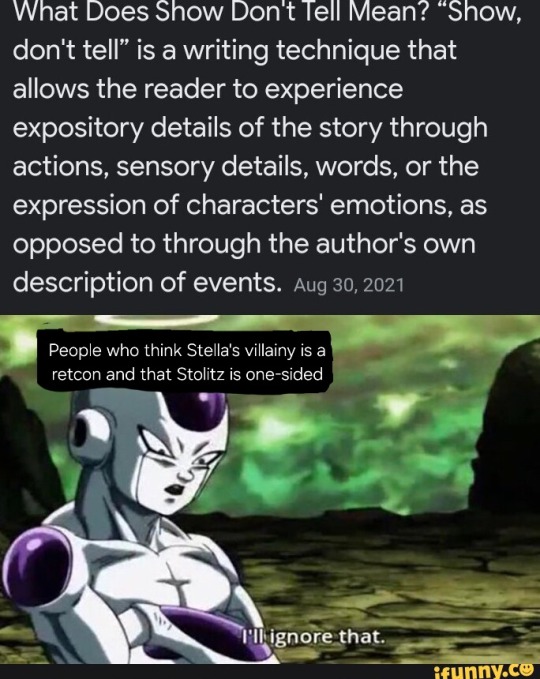
See, this is what happens when people don't count important details in storytelling just because it's not being said outright, but rather shown through character expressions without dialogue. There were hints from the beginning that Stella was always meant to be a bad person and an obstacle to Stolas' feelings for Blitzø.
Don't believe me? Watch Loo Loo Land again with more open ears and eyes. Stella is shown throwing stuff at Stolas, including his sentient plants which he values highly and she was likely aware of that. That imp butler she threw at him means she not only abuses Stolas, but her own servants too, especially those of a particular lower class race.
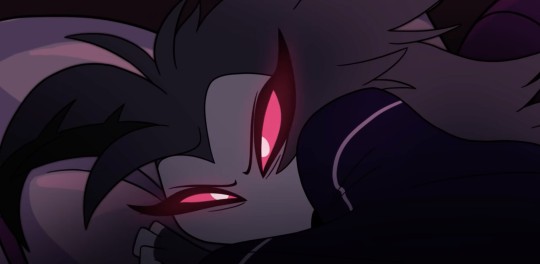
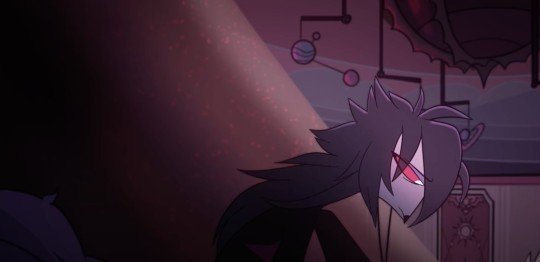
Octavia's expressions here imply that this isn't an isolated incident either. That's the look of a girl who's heard this same type of arguing from her parents everyday. With how annoyed she looks, Stolas and Stella might as well have been fighting like this for years. It'd be more surprising if they didn't.

Octavia's lack of a reaction to her mom throwing a plant that almost hit her implies that this is far from the first time Stella has thrown things around the house. That is a concerning thing to get used to. Stella is also heard yelling about Stolas sleeping with an IMP, in THEIR bed. Notice the emphasis on "imp" and "our" bed. Even Stolas' only response to that is "I didn't have time to go to a motel!" It's pretty clear here that Stella is more concerned about about Stolas cheating on her with an imp specifically and ruining her reputation than the fact that he cheated at all.
If she was truly upset about the cheating itself, she would've said something more along the lines of "I can't believe you slept with someone else!" or something like that. Throwing their imp butler and him saying "You wanna fuck this one too?" and calling Stolas "pathetic, imp-sucking face" is all you need to know that Stella is making it more about WHO Stolas cheated on her with than the fact that he cheated. Keep in mind that this argument was going on right in front of Via, who didn't even say anything or try to stop it.

Octavia here says "You two done screaming for the day?" with little emotion, and Stolas' reply basically amounts to "Yup" without hesitation. More and more proof that his marriage with Stella was NEVER happy and never something that he wanted.
Later in the episode, Via does say that her parents used to love each other, even though we as the audience know it's not true. Stolas even tries to explain to her that he and Stella were never in love to begin with, but he didn't have the words. Because how exactly can you explain to your daughter that you and your wife were in an arranged marriage since you guys were kids for the sole purpose of producing a child, without offending her and making her think she was only born for one purpose? Or better yet, what reason is there to assume that she'd actually believe you?

People have looked at this picture on the wall and somehow came to the conclusion that Stolas and Stella used to be in a happy, loving relationship based on this picture alone, just because Stella is smiling in it. But if you look cloesly, you'll see that smile on Stella is barely there. She's very obviously faking it to keep up an image. She's forcing it so people won't get suspicious. This is the vision of Stella that Octavia remembers from her youth, which is exactly why she was naive enough to believe that her parents genuinely loved each other before Blitzø came along for a one night stand in hopes of getting the grimoire. Sure, she had seen them arguing and fighting with each other before that, but that's mainly because most if not all parents have gotten into nasty arguments at some point that their children were more likely than not to witness.
Stella is barely looking at Stolas there, clearly rolling her eyes and just wanting the picture to be overwith already. Stolas is genuinely happy there, but that's because his "little owlette" is there with him. He's not looking at Stella at all. Another picture in their house with just Stolas and Stella together has both of them frowning and looking at the camera, not each other. Octavia is the only thing to come out of Stolas' marriage that ever gave him any real happiness. She was the only reason he stayed at that house.
That scene where Stella ignores Octavia's cry for help when she's having a nightmare and tells Stolas to go check on her instead is more evidence that Stella had never been a nice person or a good mother. You could argue that she was just too tired to do anything about it, but look again. Stolas was just as tired as she was, yet he still went out of way to comfort his "little Starfire" when she was having a bad dream. Octavia may have called for both of her parents, but she said she had a bad dream about her father disappearing. Not her parents, just her father.
Also notice the drawings in Octavia's bedroom when she's a child. Look at how many of them are of her and Stolas together, but Stella is nowhere to be found in those drawings. That shows how close Via is to her father, especially when she was a little girl, but was never really close to her mother at all. Sure, those drawings are no longer in Via's room when she's a teen in the present, but remember that her and Stolas gradually got less close to each other as the years went by and their relationship got more flawed, to the point that Via questions if her dad even loves her anymore and literally listens to music about hating dads. But the fact remains that there were never any drawings of Stella in her daughter's room and there still isn't now is pretty telling that Stella was never a good mom, still isn't now and likely never will be.
Now look at The Harvest Moon Festival. If Loo Loo Land didn't convince you that Stella was a bitch, then this episode sure will. Stella's only scene in the episode is her screaming into a phone while she's talking to Striker about wanting Stolas dead. Right in front of him and Octavia. While Via is listening to music that's too loud for her to have even heard the screaming, Stolas heard it pretty clearly. But he had no reaction to his own wife screeching about hiring an assassin to kill him. Him being completely unphased by something like that is surely a sign that Stella had always hated his guts and he knew about it. He likely heard her shouting at the top of her lungs about wanting to murder him with her own bare hands. If he's not reacting to Stella talking to Striker on the phone about planning his death in front of him, he might as well have been hearing shit like that from her for years.
Not counting the pilot, those are the only two scenes with Stella in season 1. Both scenes depicted her in the same light. A loud, violent bitch in a loveless marriage. Therefore, her reveal in The Circus about always hating Stolas from the get go is not a retcon. Not that there was even much known about her character for there to be retconned in the first place, but her few scenes before that episode showed her doing and saying nothing BUT horrible things.
As for Stolitz, Blitzø is more than once implied to return Stolas' feelings for him. He just never said it out loud and is in denial about his own feelings. He's not even aware that Stolas' love for him is genuine because between their reuniting at the Not Divorce Party and their fumbled fake date at Ozzie's, Stolas has only ever talked to Blitzø with sexual innuendos. So Blitzø had no reason to assume that Stolas was legitimately in love with him and didn't just want him for sexy times, because Stolas hadn't really been helping his case. Blitzø ranted to Fizzarolli about Stolas "acting" like he cared about him outside of sex.



Everytime Blitzø talks about Stolas treating him like his own personal fuck toy, he looks and sounds pretty upset about it. I doubt he'd care all that much about his relationship with Stolas being transactional fucking if he didn't like him back. Right after the fake date gone wrong at Ozzie's, Blitzø is looking at several pictures saved in his phone, one of them being a photo of him Stolas laying together in bed. Blitzø looks genuinely happy in that photo, he's even smiling. He DOES enjoy being around Stolas. When Loona comforts him after Bee's party, he can be heard whispering the names of all the people he cares about and is close to. Those people being Loona, Moxxie, Millie and.... Stolas.
In Seeing Stars, Blitzø blushes when seeing Stolas in his human form and you can see his pupils dialating for a few seconds before he changes for a few seconds. I don't know about you, but I don't blush at anyone i'm not in love with when they get a new look. Pupils dialating are also a commom indication that you're looking at something you love. Later in that episode, Blitzo nervously sweats when Stolas whispers into his ear with a seductive voice, smiles at Stolas specifically when he causes the whole audience to laugh, and holds his hand while they run out of the burning building. Blitzø did not need to hold Stolas' hand. He could've just said "Hey, let's get the fuck outta here," and Stolas wouldn't have hesitated. On top of that, they are still shown holding hands long after they escaped and only let go once they see their daughters.
Now, onto the most complicated scene involving the Stolitz relationship, during Blitzø's ball tripping hallucination where he sees Stolas on top of a staircase and is being pulled towards him with chains. Already not a good sign. But Blitzø was already climbing the staircase before the chains appeared. Even when he saw Stolas above him, he didn't run away. He briefly walked towards him before being dragged towards him. He's seen blushing once he reaches the top and Stolas caresses his face. Also notice how the art style in Blitzø's ball trip sequence was completely different from how the show normally looks, but the moment he saw Stolas the art style changed back to normal. Meaning that Blitzø feels the most like himself when he's around Stolas.
He just wants to be in a legit, healthy relationship with Stolas out of love, not the transactional fuck buddy situation he's in right now. He wishes that Stolas would stop calling him degrading nicknames like "impish little plaything" and is bothered by the power imbalance between the two of them.
"Show, don't tell" is an important writing tool that isn't respected these days. If a story isn't being anvilicious and spoonfeeding you information with heavy-handed exposition and infodumps left and right, then foreshadowing details get dismissed and ignored, with some people straight up saying they don't count because it's not being spelled out to them every 5 seconds. This is why some people still insist that Stella's villainy was retconned and that Blitzø has no interest in Stolas despite evidence to the contrary. They were paying more attention to their headcanons than what the show actually presented, and got mad when their headcanons were contradicted by canon.
#helluva boss#blitzø buckzo#stolas goetia#stella goetia#octavia goetia#stolitz#character analysis#show don't tell
322 notes
·
View notes
Note
How do you set a scene without overusing visual descriptions?
Practical Tips to Show, Don’t Tell
Show, don’t tell is probably the most common writing advice any author will ever receive. Instead of explicitly telling readers what is happening or how characters are feeling, showing allows them to experience the story firsthand. It’s good advice, and important for writers to take to heart, but sometimes it can be difficult to get the balance right. Here are some practical tips to show, don’t tell:
Set the scene
To really immerse your readers in your story, you want them to feel as if they’re in it – experiencing the world you’ve built. By writing about how characters perceive and interact with their surroundings, you’ll draw your readers in.
Examples:
Telling: It was winter, and the water was cold.
Showing: I hunched my shoulders up, burrowing deeper into my coat as my heavy boots crunched through the thin ice forming at the water’s edge.
Keep up the pace
Excess scene description will almost always bring your narrative pacing to a screeching halt. Instead of describing the scene every time, describe your characters’ actions within it.
Examples:
Telling: The lake was frozen and the trees were covered in snow.
Showing: My heart pounded as I almost lost my balance on the ice beneath my feet. I ducked and weaved my way home, dodging the snow that the howling wind shook loose from the treetops above me.
Keep your language descriptive, but simple
When it comes to show, don’t tell, it can be easy to fall into the trap of over-describing. Language that is too flowery or over the top can be just as bad as telling. You want to set a scene, not explain it to death.
Examples:
Too much: The azure-blue lake glinted like diamonds under a glittering sun that shone like a lightbulb in the darkness.
Just right: The sun reflected off the ice brightly, highlighting the deep blue of the water beneath it.
Create a sense of character
The way a character speaks and acts can be the perfect way to show your readers who they are and set a scene without over-describing it. For example, you can use body language, like gestures and posture to reveal a character’s emotions or attitude in a way you can’t reveal by simply describing the scene. Sometimes an intricate description of the location is not as important as how the character feels in the moment
Examples:
Telling: The room was the same as he remembered as a child, with its red carpets, brown-papered walls, high ceilings, and huge wooden table propped in front of large bay windows. It made him anxious.
Showing: He shuffled anxiously to the table overlooking the garden, his mind heavy with the weight of childhood memories.
#writers#creative writing#writing#writing community#writers of tumblr#creative writers#writing inspiration#writeblr#writerblr#writing tips#writblr#show don't tell#writers block#help for writers#helping writers#advice for writers#writing advice#creative writing resources#writing resources#writer resources#writers corner#let's write#learn to write#advice for authors#writing help#writing characters#showing not telling#show dont tell#descriptive writing
798 notes
·
View notes